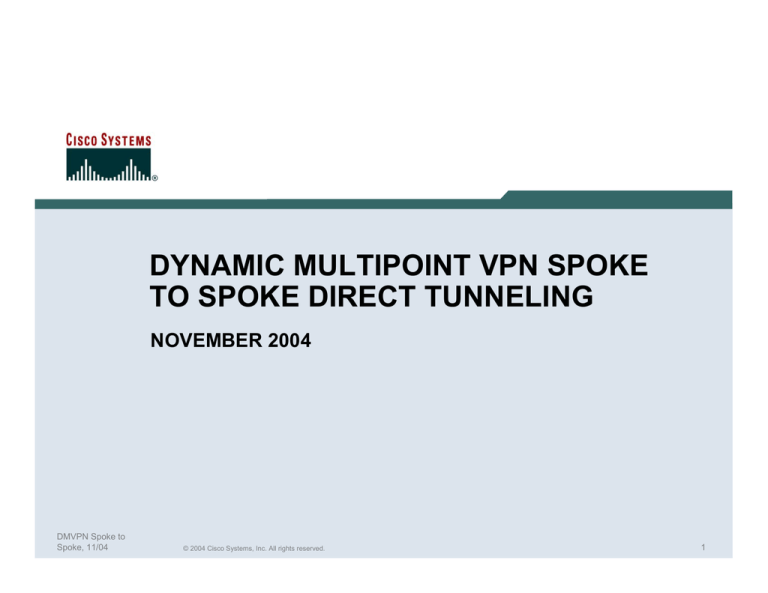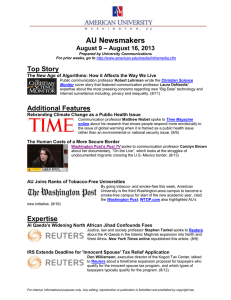
DYNAMIC MULTIPOINT VPN SPOKE
TO SPOKE DIRECT TUNNELING
NOVEMBER 2004
DMVPN Spoke to
Spoke, 11/04
© 2004 Cisco Systems, Inc. All rights reserved.
1
Direct Spoke To Spoke Tunnels
• Initially, spoke to spoke traffic can only travel via
the hub
• In DMVPN, spokes can send packets directly to
another spoke, if the routing table and NHRP table
are available
• This does not change the principle so far
DMVPN Spoke to
Spoke, 11/04
© 2004 Cisco Systems, Inc. All rights reserved.
2
Routes and NHRP Between Two Spokes
Tunnel address:
10.0.0.11/24
NBMA address:
172.16.1.2/24
192.168.1.0/24
Tunnel address:
10.0.0.1/24
NBMA address:
172.17.0.1/24
192.168.0.0/24
NHRP Table
Routing Table
10.0.0.1 -> 172.17.0.1
192.168.0.0/24 ->
10.0.0.12 -> 172.16.2.2
Tunnel 0, via 10.0.0.1
192.168.2.0/24 ->
Tunnel 0, via 10.0.0.12
NBMA address:
172.16.2.2/24
Tunnel address:
10.0.0.12/24
192.168.2.0/24
DMVPN Spoke to
Spoke, 11/04
© 2004 Cisco Systems, Inc. All rights reserved.
3
Learning process
• In order to create a spoke to spoke tunnel, a spoke
must
Learn a routing entry to the destination network
The next hop must be the remote spoke tunnel IP address
The spoke must learn the NBMA address of this next hop
• The IPsec tunnel is only built after that
DMVPN Spoke to
Spoke, 11/04
© 2004 Cisco Systems, Inc. All rights reserved.
4
Route Learning
• The routing protocol is only between the hub and
the spokes
• In order for spoke to spoke to work, the hub must
preserve and advertise the private networks next
hop as advertised by the spokes themselves
DMVPN Spoke to
Spoke, 11/04
© 2004 Cisco Systems, Inc. All rights reserved.
5
Route Learning (cont’d.)
• RIP keeps the next-hop information by default
This can not be disabled
• The next-hop preservation in EIGRP is not a default
It is turned on with the interface command
no ip next-hop-self eigrp <as>
• Next hop preservation in BGP is a default
It can be disabled with the BGP command
neighbor <n> next-hop-self
• In OSPF, next-hop preservation happens naturally except in
point-to-multipoint mode
DMVPN Spoke to
Spoke, 11/04
© 2004 Cisco Systems, Inc. All rights reserved.
6
NHRP Learning
• A spoke will send an NHRP resolution request to its
NHS to learn an NBMA address
• The queried address can be a network address
• Ideally, the queried address should be a next-hop
address
• The NHS will respond with an NBMA address from
its cache
The spoke will populate its cache with the answer
DMVPN Spoke to
Spoke, 11/04
© 2004 Cisco Systems, Inc. All rights reserved.
7
NHRP Learning (cont.)
• The resolution reply will have a lifetime set to the
remaining lifetime in the hub cache
• If the NHS does not have the entry in its cache, it
returns an error and the spoke will install an
incomplete entry and forward packets to the NHS
• During the learning process, the spoke will forward
all the packets to its NHS
This occurs in process switching
DMVPN Spoke to
Spoke, 11/04
© 2004 Cisco Systems, Inc. All rights reserved.
8
Tunnel Buildup
• As soon as the NHRP entry is created but NOT
inserted in the cache, an IPsec tunnel will be
initiated
• The NHRP entry will be inserted in the cache and
used when the IPsec tunnel is actually ready
• The IPsec tunnel will disappear when the NHRP
entry times out
DMVPN Spoke to
Spoke, 11/04
© 2004 Cisco Systems, Inc. All rights reserved.
9
NHRP Registration
Dynamically Addressed Spokes
= Dynamic IPsec tunnels
NHRP mapping
Physical: 172.17.0.1
Tunnel0:
10.0.0.1
Routing Table
192.168.0.0/24 Æ Conn.
192.168.1.0/24 Æ 10.0.0.11
192.168.2.0/24 Æ 10.0.0.12
Spoke A
10.0.0.1 Æ 172.17.0.1
10.0.0.12 Æ 172.16.2.1
192.168.0.0/24 Æ 10.0.0.1
192.168.1.0/24 Æ Conn.
192.168.2.0/24 Æ 10.0.0.12
DMVPN Spoke to
Spoke, 11/04
10.0.0.11 Æ 172.16.1.1
10.0.0.12 Æ 172.16.2.1
Physical: 172.16.2.1
(dynamic)
Tunnel0: 10.0.0.12
Physical: 172.16.1.1
(dynamic)
Tunnel0: 10.0.0.11
192.168.1.1/24
192.168.0.1/24
© 2004 Cisco Systems, Inc. All rights reserved.
Spoke B
192.168.2.1/24
10.0.0.1 Æ 172.17.0.1
10.0.0.11 Æ 172.16.1.1
192.168.0.0/24 Æ 10.0.0.1
192.168.1.0/24 Æ 10.0.0.11
192.168.2.0/24 Æ Conn.
10
Building Spoke-Spoke Tunnels
Host1
Spoke1
Hubs
NHRP Resol. Req.
Spoke2
Host2
NHRP Resol. Req.
IKE Initialization
NHRP Resol. Req.
NHRP Resol. Req.
IKE Initialization
IKE/IPsec Established
NHRP Resolution Replies
Encrypted
DMVPN Spoke to
Spoke, 11/04
© 2004 Cisco Systems, Inc. All rights reserved.
11
IKE Call Access Control
• IKE Call Access Control (CAC) was introduced in
Release 12.3(8)T
• This feature allows Cisco IOS® Software to limit the
number of IKE/IPsec connections
• It prevents small platforms from opening dozens of
spoke to spoke tunnels (e.g. worm attack)
crypto call admission limit ike sa <number>
DMVPN Spoke to
Spoke, 11/04
© 2004 Cisco Systems, Inc. All rights reserved.
12
DMVPN Hub Configuration
crypto ca trustpoint CA
enrollment terminal
crl optional
rsakeypair hub1
crypto ca certificate chain CA
certificate 2368DB55000000000B4E
certificate ca 1244325DE0369880465F977A18F61CA8
!
crypto isakmp policy 1
encryption 3des
!
crypto ipsec transform-set ts esp-3des esp-sha-hmac
!
crypto ipsec profile prof
set transform-set ts
!
interface Ethernet0/0
ip address 192.168.0.1 255.255.255.0
!
interface Serial1/0
ip address 172.17.0.1 255.255.255.252
DMVPN Spoke to
Spoke, 11/04
© 2004 Cisco Systems, Inc. All rights reserved.
13
DMVPN Hub Configuration (Cont’d.)
interface Tunnel0
bandwidth 1000
ip address 10.0.0.1 255.255.255.0
ip mtu 1416
ip nhrp map multicast dynamic
ip nhrp network-id 100000
ip nhrp holdtime 3600
no ip split-horizon eigrp 1
no ip next-hop-self eigrp 1
delay 1000
tunnel source Serial1/0
tunnel mode gre multipoint
tunnel key 100000
tunnel protection ipsec profile prof
!
router eigrp 1
network 10.0.0.0 0.0.0.255
network 192.168.0.0
no auto-summary
DMVPN Spoke to
Spoke, 11/04
© 2004 Cisco Systems, Inc. All rights reserved.
For spoke to
spoke configs
14
DMVPN Spoke Configuration
crypto ca trustpoint CA
enrollment terminal
crl optional
rsakeypair spoke1
crypto ca certificate chain CA
certificate 236FD380000000000B4F
certificate ca 1244325DE0369880465F977A18F61CA8
!
crypto isakmp policy 1
encryption 3des
!
crypto ipsec transform-set ts esp-3des esp-sha-hmac
!
crypto ipsec profile prof
set transform-set ts
!
interface Ethernet0/0
ip address 192.168.1.1 255.255.255.0
!
interface Serial1/0
ip address 172.16.1.1 255.255.255.252
DMVPN Spoke to
Spoke, 11/04
© 2004 Cisco Systems, Inc. All rights reserved.
15
DMVPN Spoke Configuration (Cont’d.)
interface Tunnel0
bandwidth 1000
ip address 10.0.0.11 255.255.255.0
ip mtu 1416
ip nhrp map multicast 172.17.0.1
ip nhrp map 10.0.0.1 172.17.0.1
ip nhrp network-id 100000
ip nhrp holdtime 3600
ip nhrp nhs 10.0.0.1
ip nhrp server-only
delay 1000
tunnel source Serial1/0
tunnel mode gre multipoint
tunnel key 100000
tunnel protection ipsec profile prof
!
router eigrp 1
network 10.0.0.0 0.0.0.255
network 192.168.1.0
no auto-summary
DMVPN Spoke to
Spoke, 11/04
© 2004 Cisco Systems, Inc. All rights reserved.
For pure hub and
spoke
16
Recommendation
• The use of wildcard pre-shared keys is strongly
discouraged
• With such topologies, it is recommended to use a
Public Key Infrastructure (PKI) to authenticate
nodes
DMVPN Spoke to
Spoke, 11/04
© 2004 Cisco Systems, Inc. All rights reserved.
17
DMVPN Spoke to
Spoke, 11/04
© 2004 Cisco Systems, Inc. All rights reserved.
18






